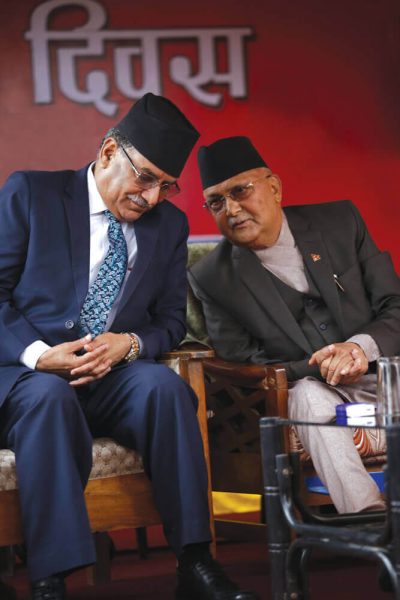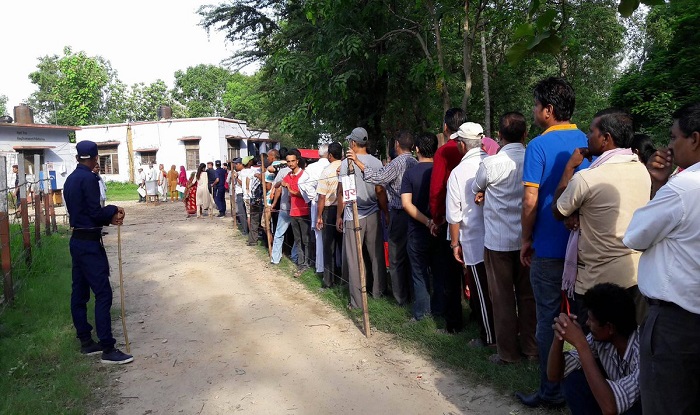Becoming a Democracy—The Example of Nepal

Hardly noticed on the world landscape of emerging democracies lies Nepal. This new republic now has its first government, newly formed this past February, under a secular constitution. It’s a route scattered with the detritus of its becoming a republic, though still a relatively nonviolent path.
Why is the international press not following Nepal’s embryonic struggle?
Perhaps it’s the stunning northern horizon that distracts observers from realities across the populated hills and plains. Perhaps it’s the pollution in Kathmandu Valley, a choking haze that matches the gaseous airs of Delhi in India and Beijing in China. Or, it may be because this democracy has been largely brought about and led by Nepal’s Maoists and Communists.
Last autumn, many among the Himalayan nation’s 28 million people were themselves surprised when two veteran, leftist leaders KP Sharma Oli (UML-United Marxist Leninist) and Pushpa Kamal Dahal (CPN-Communist Party of Nepal) agreed to form a coalition. That step was taken not after, but before, the nationwide election. Agreeing not to compete with one another and selecting candidates from their combined ranks, they prevailed in the polls. Together they won a majority of seats at national and local levels, and in rural as well as urban regions. See this. (The prime-minister’s post as head of the new government was also chosen by mutual consent.) This coalition furthermore drove the once dominant Congress Party to the margins of power across the country.
Last month, these former contenders went a step further, announcing that this victorious joint force is no longer CPN/UML but a new entity, the Nepal Communist Party (NCP). See this. With 174 seats in the 275-member parliament, the NCP leads the most powerful government modern Nepal has seen. A highly unexpected development, this could finally convince a skeptical public that the inter-left competition that had caused years of instability and fed corruption is over… for the present. (The legal term limit of each administration is five years. But given Nepal’s history of unstable coalitions, this could change.)
Both Oli and Dahal had each previously held the post of Prime Minister, interrupted by short periods when the office was held by a Congress Party leader. Gently ousted after a few months of infighting, none was able to lead effectively. Constant changes of leadership cultivated an atmosphere for corruption and also thwarted implementation of any sustained policy. (E.g. opposition parties would promise to support a weak leadership in exchange for appointments for their members and funding for various personal ‘projects’. With the result that, for example, the prime minister found himself with a cabinet of some 30 members, and an office full of deputy prime-ministers almost as dense.)
Nepal’s federal election last autumn was particularly significant. It was the first poll undertaken under the new constitution that defined the republic created in 2008, following the 2006 peace accord with the Maoist insurgents, and the (bloodless) 2007-2008 abolition of the ancient and despotic monarchy. (See Nepal’s political timeline from 1768 to 2017.)
The nationwide citizens’ vote was delayed for years; endless disputes and disagreements had undermined the work of the Constituent Assembly. Without laws defining the shape of the republic–administrative districts and provinces, powers of office, quotas for Nepal’s many ethnic groups and women—(finally agreed upon in 2015) an election could not go ahead.
Nepalis queueing to vote. (Source: Bing stock file)
The public did not know what to expect once the vote was scheduled (in November, 2017). After the two leftist party leaders announced their coalition, few observers in Kathmandu believed it would work out. When the unified plan actually succeeded in winning a comfortable majority, citizens still remained cautious. Interviewing women and men in the capital recently, in the early months of the new government, I found less enthusiasm than I’d expected. The election did not yet assure them real stability, it seemed. In Nepal’s non-affiliated press, I read neither expressions of satisfaction nor pride. News reports were not as celebratory as expected.
“Let’s see”, cautioned several individuals who I questioned. “It’s too early to say; other factors will be operating”, one journalist hinted. (Whatever the nature of Nepal’s governance, India is a major player, and she was referring to India’s expected claims on the new leadership.)
Doubts about the durability of the new alliance are not unreasonable. Nepal’s leftists have been squabbling and undermining each other for so long that an enduring union seemed unlikely. Then there was the threat from the large bloc of Madhesi parties. They had earlier disrupted the efforts of the Constitutional Assembly with their regional/ethnic demands. (The strip of Nepal bordering India is known as Madhes or Terai. Nepal’s Madhesi maintain close economic and cultural ties to its southern neighbor and there had been fears that, if not mollified, the Madhesi parties might try to secede to India.) In the recent election, the majority of Madhesi voters unexpectedly backed the joint MLN-CPN.
After the election, citizens next waited to see how the coalition would handle the single office of Prime Minister. Again skeptics were surprised by an easy resolution. The partners agreed without rancor that the job go to KP Sharma Oli. (Today, after holding office for four months, Oli remains the unquestioned leader.) He has just returned from a visit to China, following an initial obligatory meeting with his Indian counterpart, Mr. Modi.
Nepal relies on major assistance from both its northern and southern neighbors. Increasingly, with the economic ascendancy of China, Beijing’s role in Nepal is expanding. One sees an enhanced Chinese presence in the tourism industry– on the streets of Kathmandu, in yoga centers and along trekking routes– as well as in major infrastructure and health projects.
*
Barbara Nimri Aziz is an anthropologist, journalist and producer at Pacifica-WBAI Radio in New York. Author of numerous academic articles on Nepal and Tibet, Aziz’ book Heir to a Silent Song: Two Rebel Women of Nepal, was published by Tribhuvan University, Kathmandu and is available through Barnes and Noble in USA. She is a frequent contributor to Global Research.
Featured image is from the Nepali Times.


